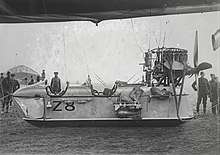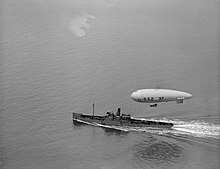SSZ class airship
The SSZ (Sea Scout Zero) non-rigid airships or "blimps" were developed in United Kingdom during World War I from the earlier SS ("Sea Scout") class. The main role of these craft was to escort convoys and scout or search for German U-Boats. A secondary purpose was to detect and destroy mines.[1]
| SSZ class | |
|---|---|
| Role | Patrol airship |
| National origin | United Kingdom |
| First flight | 1916 |
| Primary user | Royal Navy |
| Number built | 77 |
Design and development


The SSZ was built at the Royal Naval Air Service (RNAS) airship station at Capel-le-Ferne[2] near Folkestone to the design of three officers that were serving there[3] as a successor to the SS class.[4]
Similar to other SS class types, the SSZs had an envelope of 70,000 cu ft (2,000 m3) capacity containing two ballonets of 6,375 cu ft (180.5 m3) each;[5] and like the SSPs, the fuel was contained in aluminium tanks slung on the axis of the envelope.[6]
The design of the car was a departure from that of other SS types. It was streamlined, boat-shaped and watertight, was floored from end-to-end, and was enclosed with sides of fabric-covered 8-ply wood[3] or aluminium. The car was comfortable and accommodated a 3-man crew – the forward position being occupied by the wireless operator/gunner with the pilot seated amidships, and the engineer was stationed at the rear.[6]
A single water-cooled 75 hp (56 kW) Rolls-Royce Hawk engine was mounted on bearers above the level of the rear of the car, and drove a 9 ft (2.7 m) diameter four-bladed propeller in pusher configuration.[6]
The SSZ design was judged superior to the SSP, which had been developed at RNAS Kingsnorth at the same time, and so the SSP was cancelled.[4]
Operational history
The SSZ's patrolled extensively from late 1917 to late 1918. The average patrol lasted eight hours, but there were instances of flights of much greater duration – three of 25–26 hours; one of 30 h 20 min; and a record of 50 h 55 min held by SSZ.39 in the summer of 1918.[6] After the Armistice SSZ-73 became the only airship to fly under a bridge. Maj. Thomas Elmhirst (CO RNAS Anglesey), piloted SSZ-73 under the Menai Suspension Bridge. The act did not harm Elmhurst's career.[7]
On 16 August 1918, a makeshift SSZ ship was being assembled from the old SSZ-23 envelope and a spare SS Zero car at RNAS Howden airship station.[8] Petrol fumes from a spillage in the car were ignited some time later by a spark when the radio equipment was being tested, and the ensuing fireball, fed by fuel and gas, completely enveloped and destroyed the old SSZ-23 envelope/spare car hybrid and R23X class airship R27 which were sharing a hangar.[8] Although the hangar itself survived, one airman lost his life, and two further blimps that were moored nearby, SSZ.38 and SSZ.54, were also destroyed.[9]

The SSZ's greater stability in flight and longer endurance enabled them to operate in worse weather conditions than had previously been attempted,[6] and early in 1917 all existing SS types were superseded by the SS Zero.[2] They were turned out as fast as they could be built, and a total of 77 SSZs were produced between 1916 and 1918, two of which were acquired by France and two by the United States.[5] The US Navy operated two SSZ's. SSZ-23 (A-1030),and SSZ-24 (A-1029), the SSZ-23 envelope was destroyed in a hangar fire Howden in 1918, SSZ-23 the car was sent from Howden to the US on 4 August 1918.[10] SSZ-24 apparently burned at Hampton Roads in the summer of 1918.[11] The SSZ-23 was at Cape May, NJ, for erection on 5 February 1919. The SSZ-23 was with drawn by mid-1920.[12]
Specifications
Data from [5]
General characteristics
- Crew: 3
- Length: 143 ft 5 in (43.70 m)
- Diameter: 30 ft 0 in (9.10 m)
- Volume: 70,000 cu ft (2,000 m3)
- Useful lift: 1,334 lb (605 kg)
- Powerplant: 1 × Rolls-Royce Hawk , 75 hp (56 kW)
Performance
- Maximum speed: 53 mph (85 km/h, 46 kn)
- Rate of climb: 1,200 ft/min (6.1 m/s)
Armament
- 1 x Lewis Gun
- 2 x 110 lb (50 kg) bombs or 1 x 250 lb (110 kg) bomb
See also
- Comparative specifications for all SS class variants
- British blimps operated by the USN
- List of aircraft of the Royal Naval Air Service
References
Notes
- TAnti-Submarine Warfare in World War I: British Naval Aviation. Retrieved on 13 September 2018.
- Twenty-One Years of Airship Progress. flightglobal.com. Retrieved on 28 March 2009.
- Whale (2008), p.60.
- Castle (2009) p23
- SSZ data. Airship Heritage Trust. Retrieved on 18 March 2009.
- Whale (2008), p.61.
- Mowethorpe, Ces, Battlebags British Airships of the First World War, 1995, Alan Sutton Publishing Limited, Phoenix Mill, Far Trupp Stroud, Gloucestershire ISBN 0-7509-0989-7 page 109
- Mowethorpe, Ces, Battlebags British Airships of the First World War, 1995, Alan Sutton Publishing Limited, Phoenix Mill, Far Trupp Stroud, Gloucestershire ISBN 0-7509-0989-7 page 84
- HMA 23X Airship Heritage Trust. Retrieved on 28 March 2009.
- Mowethorpe, Ces, Battlebags British Airships of the First World War, 1995, Alan Sutton Publishing Limited, Phoenix Mill, Far Trupp Stroud, Gloucestershire ISBN 0-7509-0989-7 page 88
- Shock, James R., U.S. Navy Airships 1915-1962, 2001, Atlantis Productions, Edgewater Florida, ISBN 0-9639743-8-6, page 45
- Shock, James R., U.S. Navy Airships 1915-1962, 2001, Atlantis Productions, Edgewater Florida, ISBN 0-9639743-8-6, pages 44-45
Bibliography
- Jane's All the World's Aircraft 1919. London: Sampson Low Marston. pp. 8c.
- Whale, George (2008). British Airships: Past Present and Future. Toronto, Canada: Bastian Books. p. 124. ISBN 0-554-30772-3.
- Castle, Ian (2009), British Airships 1905–30, New Vanguard, Osprey Publishing
- Mowethorpe, Ces (1995). Battlebags British Airships of the First World War. Alan Sutton Publishing Limited, Phoenix Mill, Far Trupp, Stroud, Gloucestershire. ISBN 0-7509-0989-7.
- Shock, James R. (2001). U.S. Navy Airships 1915-1962. Atlantis Productions, Edgewater Florida. ISBN 0-9639743-8-6.
External links
| Wikimedia Commons has media related to SSZ class blimp. |